6.6 LIFTS
6.6.1 General
All lift installations and operations shall comply with SS 550.
Lift well shall be vented in accordance with SS 550.
6.6.3 Emergency power supply
a. Emergency power supply for lighting, ventilation and alarm systems for all lifts shall comply with the requirements in SS 550.
b. A standby generating plant shall be provided for: (1) homing of lifts during an emergency for:
(1) homing of lifts during an emergency for:
(a) PG II buildings with private lifts or that which exceed the habitable height of 60m;
(b) mixed-use residential buildings where the lifts serve the residential and/or non-residential floor(s);
(d) all basement occupancies (excluding PG I buildings or basements within single household dwelling houses classified as cluster housing within PG II developments).
Effective Date: 1 Mar 2023
(2) operating of the following lifts during an emergency:
(a) fire lifts;
(b) PWD evacuation lifts for buildings exceeding four storeys and buildings which require the provision of such lifts; and
(c) fire escape bed lifts.
Effective Date: 01 Mar 2019
c. The power supply to the lift shall be connected to a sub-main circuit exclusive to the lift and be independent of any other main or sub-main circuits. The power cables serving the lift installation shall be routed through an area of negligible fire risk.
6.6.4 Fire lift
a. General
(1) The installation of the fire lift shall be in accordance with SS 550.
(2) The fire lift(s) shall be contained within a separate protected shaft. Alternatively, the fire lift(s) can be contained within a common protected shaft containing other lifts, provided such other lifts are served at each storey by the fire lift lobby.
E(3) The fire lift shaft shall be continuous throughout the building and serve every storey except a non-habitable roof.
(4) A lift mainly intended for the transport of goods shall not be designated as a fire lift.
(5) Cargo lift shall not open into a fire lift lobby.
(6) In the case of motor-room-less fire lifts, the fire lift control panel enclosure located at the fire lift lobby shall be compartmented with a fire-rated door of same rating as the lift shaft.
Effective Date: 01 Mar 2019
It is common to find goods being stacked in lobby outside goods lifts. This would affect the firefighters while carrying out firefighting operations during an emergency.
b. Number of fire lifts
(1) With the exception of PG I and II buildings, all other buildings shall be provided with at least two fire lifts if the habitable height exceeds 24m.
(2) For PG II buildings, at least one fire lift shall be provided if the habitable height exceeds 24m. In the case of super high-rise (above 40 storeys) residential buildings, at least two fire lifts shall be provided.
(3) All buildings, except PG I, shall also be provided with at least two fire lift if the depth of the basement exceeds 9m below the average grade level.
Ec. Accessibility and coverage
(1) A fire lift shall be located such that the travel distance between the nearest edges of the lift landing door and exit staircase door is not more than 5m. In addition, the exit staircase shall be approached through a fire lift lobby or a corridor connected directly to a fire lift lobby at each storey. This corridor shall comply with fire lift lobby requirements except that the width can be at least 1.2m.
Exception:
(a) The final discharge of exit staircase at ground level for all buildings, the travel distance between the nearest edge of the fire lift landing door and exit staircase door can be extended to at most 10m. Where the travel distance between the nearest edge of the fire lift landing door and exit staircase door exceeds 5m, additional signage shall be displayed prominently at the fire lift lobby to indicate the location of exit staircase door.
(b) In cases when two fire lifts are located adjacent to each other, only one of the two fire lifts need to comply with the 5m requirement.
Effective Date: 1 Sep 2024
(2) The fire lift shall be located such that any part of every storey shall be accessible by firefighters from the fire lift.
E(3) Regardless of whether the building is installed with an automatic sprinkler system, the number of fire lifts required shall be such that any part of a storey of the building is within 60m coverage from the fire lift door, subject to the provision of at least two fire lifts in accordance with Cl.6.6.4b.(1) & (3).
d. Fire lift switch
(1) The operational features of the fire lift shall be provided in accordance with SS 550, including the provision of a fire lift switch.
(2) A fire lift switch shall be provided at both the designated and alternate designated floors.
Effective Date: 01 Mar 2019
6.6.5 Evacuation lift
a. General
Evacuation lifts shall be provided for evacuation of occupants requiring assistance during an emergency. The requirements stipulated herein shall be applicable to all, except PG I and II, buildings:
(1) exceeding 24m in habitable height, or
(2) accessible to PWDs, except those stipulated under Cl.2.4.1a..
b. Provisions
(1) For buildings provided with at least two fire lifts, one of the fire lifts can be used for the evacuation of occupants, including PWDs.
(2) Where a fire lift serves the dual purpose of an evacuation lift for PWDs, it shall have a clear car platform area of minimum 1.2m by 1.4m instead of 1.45m2. For PG II buildings having more than 40 storeys, the minimum clear car platform size of the fire lift shall be at least 1.7m by 1.5m.
(3) For buildings without a fire lift, at least one of the passenger lifts shall be designated as a PWD evacuation lift.
(4) All passenger lifts in buildings exceeding 24m in habitable height shall be designed for use together with the fire lifts so as to speed up occupant evacuation.
c. Communication
(1) A lift monitoring system shall be provided within the FCC. It shall monitor the floor location of the lift, direction of travel, status with respect to occupation, both the normal and emergency power supplies to the lifts, and activation of a fire alarm within the lift shaft or lift motor room or lift lobby. Provision to manually override the lift shall be installed in the FCC for use by the firefighters/ CERT if required.
(2) A voice communication system shall be provided in the building.
(3) An intercom system in the lift car shall be provided for communication between the lift operator and the FCC.
(4) CCTV cameras shall be installed at lift lobbies to facilitate situational awareness for the authorised personnel overseeing the evacuation at the FCC or 24-hourly manned station. Alternatively, a suitable means of communication to call for assistance during a fire can be provided between the protected lobby and FCC or any 24-hourly manned station. It can be in the form of a distress button or voice communication.
(5) The means of communication shall be:
(a) located between 800mm and 1200mm above ground level;
(b) appropriately labelled;
(c) provided with prominently displayed clear instruction signage on its operation; and
(d) when activated, generate a clear visual indication for the person requesting for assistance to know that the distress signal has been relayed.
R Rationale - ClauseThe purpose is to enable the person requiring assistance to alert the FCC or the manned station that they are in need of assistance and for them to be reassured that this assistance will be forthcoming
d. Evacuation switch
(1) A switching device, similar to the fire lift switch, shall be installed next to each evacuation lift landing door on the designated floor (and the alternate designated floor, if provided) for persons authorised by the building owner or firefighters to activate the evacuation mode of the lift.
(2) Under the evacuation mode, the lift operation shall be similar to the firefighters service operation as stipulated in the SS 550.
(3) The switching device shall be housed in a breakable glass-fronted box marked “Evacuation Switch”.
e. Signage
(1) For buildings provided with a PWD evacuation lift, a prominent sign marked “Evacuation Lift” shall be affixed onto the wall adjacent to the lift door at every landing of the evacuation lift.
f. Protected lobby
(1) Evacuation lifts shall be located within a protected lobby such as a smoke-free lobby, external exit passageway or external corridor.
(2) For buildings not exceeding 4 storeys, the provision of a protected lobby for PWD evacuation lift is not required. However, should passenger lifts be installed in such buildings, these lifts shall be provided with a lift evacuation switch for use by emergency responders. If there is no protected lift lobby provided for the said passenger lifts, the PWD Holding Point shall be located inside a protected exit staircase or along the external corridor.
g. Secondary evacuation lifts
(1) All passenger lifts in buildings exceeding 24m in habitable height shall comply with all of the following requirements:
(a) A secondary evacuation switch (labelled accordingly) shall be provided at the FCC for each passenger lifts.
(b) Power cables shall be routed through an area of negligible fire risk.
(c) Close circuit television shall be provided at all lift lobbies.
(2) The passenger lifts provided with a secondary evacuation switch need not be backed up by a secondary source of supply for evacuation operation.
6.6.6 Homing of lifts
a. For buildings requiring fire alarm system
(1) In a fire emergency, when any one of the fire detection devices or fire alarm systems is activated, all the lifts, including passenger, service, designated fire and designated evacuation lifts, shall be brought to the designated floor (usually 1st storey). Otherwise, the lifts shall home to an alternate designated floor (if the designated floor is a fire floor) and park with the lift landing doors remaining opened.
(2) Goods lifts with automatic doors shall be similarly homed to the designated floor.
(3) Goods lifts with manual doors shall be homed if the doors are closed.
Effective Date: 01 Mar 2019
b. For buildings requiring standby generating plants
(1) In the event of power failure or power interruption in the building, the supply to the lifts shall be automatically switched over to the emergency power supply from the generating plant.
(2) The lifts shall be brought to the designated floor and park with the lift landing doors remaining open until all the lifts have been brought down to the designated floor.
(3) Thereafter, one or more lifts can resume operation depending on the capacity of the emergency generating plant, in addition to the fire lift.
(4) Normal operation of the lift shall be automatically reset on the return of normal power supply.
c. For buildings which do not require standby generating plants, and for buildings with standby generating plants but without automatic fire alarm or sprinkler system
(1) For buildings without standby generating plants, the smoke/ heat detectors shall form part of the lift system and shall be connected to the lift control panel to home the lift under normal power upon activation. All lifts, including hydraulic lifts, shall be provided with Automatic Rescue Device (ARD). The ARD shall permit the lifts to move and park at the nearest lift landing floor with the lift/ landing doors open in the event of power failure. Homing any of the lifts to a basement storey is not permitted.
(2) Smoke/ heat detectors shall be provided at all lift lobbies such that all lifts serving the same lobby shall be brought to the designated floor or alternate designated floor upon activation of the detectors. For buildings without a fire alarm system, the smoke/ heat detectors shall form part of the lift system and shall be connected to the lift control panel to home the lift under normal power upon activation.
(3) The above requirements on homing of lifts need not be applied to residential buildings under PG I or lifts serving within single household dwelling houses classified as cluster housing within PG II developments.
Effective Date: 1 Mar 2023
d. For mixed developments comprising residential and non-residential components
(1) All lifts which serve the residential and non-residential floors shall be required to home to the designated or alternate designated floor (if the designated floor is a fire floor) in the event of power failure and/ or fire. The lifts shall be provided with secondary power supply from standby generating plant of sufficient capacity.
(2) Where the passenger lifts serve only the residential floors and by-pass the non-residential floors in a protected shaft, the lifts shall be required to be installed with Automatic Rescue Device (ARD), provided the habitable height of the highest floor does not exceed 60m.
(3) Where the lifts serve the upper residential floors and the basement non-residential floor(s), including car parks, the lifts shall be provided with emergency power supply from a standby generating plant for homing to the designated floor when there is a power failure in the building. In a fire emergency, the lifts shall be brought to the designated floor or alternate designated floor (if the designated floor is a fire floor) when any of the fire alarm systems in the basement non-residential floor(s) is activated.
e. Requirements for alternate designated floor
(1) An alternate designated floor (e.g., 2nd storey) shall be identified.
(2) The lifts shall be brought to the alternate designated floor in the event of a fire at the designated floor.
E(3) Localised detectors
(a) Localised detector(s) shall be provided to cover the lift landing space at the designated floor.
(b) The activation of any of the localised detectors or any other detectors or sprinklers covering the designated floor shall cause all the lifts to be re-directed to home to the alternate designated floor.
(c) The localised detector(s) shall cover the area within at least 3m surrounding the lift landing door opening.
(d) Where the lift landing is protected by a fire-rated enclosure, only the space within the enclosure is required to be covered by localised detector(s).
Effective Date: 01 Mar 2019
(4) The alternative alternate floor shall have minimum fire hazard and pre-selected for the homing of passenger lifts, and where people can escape to safety in an exit staircase or other exit from the lift landing door.
(5) In building under Cl.6.6.6c. which are not provided with sprinklers or automatic fire alarm system, suitable sensors shall be provided at the ceiling level to cover the lift landing space. The activation of any sensor shall cause the lifts to be re-directed to home to the alternate floor.
(6) The above requirements on homing of lifts to an alternate designated floor need not be applied to standalone open-sided car parks and residential buildings under PG I.
6.6.7 Provisions for lift rescue
a. General
The following requirements shall apply to buildings with blind lift hoist ways exceeding 11m, except for PG I buildings. They shall be read in conjunction with SS 550.
b. Rescue hooks
(1) When the distance between consecutive lift landing doorsills is more than 11m but less than 18m (see Diagram 6.6.7b.(1) – 1), rescue hooks complying with Cl.6.6.7b.(3) shall be provided at the underside of the upper lift landing door head (see Diagram 6.6.7b.(1) – 2).
(2) Alternatively, these hooks shall be installed in the ceiling space directly above the upper lift landing door, such that the heights of these hooks are not more than 3m above the finished floor level of that upper lift landing, and at an approximate distance of 1m away from the lift shaft wall. The ceiling space shall be easily accessible, and a sign shall be provided to indicate the locations of the rescue hooks (see Diagram 6.6.7b.(1) - 1& 2).
(3) Rescue hook design
Each rescue hook shall have pull-out strength of at least 1000kg (10kN) and a thickness of at most 14mm in diameter. The clear space between the hook and the emergency door frame shall not be less than 100mm, and the spacing between the two hooks shall be between 500 to 700mm. (see Diagram 6.6.7b.(3)).
c. Landing emergency doors
(1) Where the distance between consecutive lift landing doorsills exceeds 18m, intermediate landing emergency doors shall be provided, such that the distance between sills is at most 18m. However, for adjacent cars fitted with car emergency doors complying with Cl.6.6.7d., intermediate landing emergency doors are not required.
(2) The landing emergency doors shall conform to all of the following requirements (see Diagram 6.6.7c.(2)):
(a) The dimension of landing emergency doors shall comply with the requirements of SS 550.
(b) The dimensions of car emergency doors shall comply with the requirements of SS 550.
(c) They shall be either of the horizontally sliding or swinging single-leaf type.
(d) They shall be self-closing and self-locking and shall be marked in letters not less than 50mm high: “DANGER, LIFT WELL”.
(e) They shall be provided with a landing door lock which can be unlocked only from the landing side through the use of a key. The lock shall not be unlocked by any key which will open any other lock or device used for any other purpose in the building. The key shall be kept where it is accessible only to authorised persons.
(f) Each door shall be provided with an electrical contact, the opening of which will render the lift inoperable.
(g) Two rescue hooks complying with Cl.6.6.7b.(3) shall be provided at the underside of each emergency door head. Alternatively, these hooks
can also be installed in the ceiling space as stipulated under Cl.6.6.7b.(2).
Effective Date: 1 Mar 2022
d. Car emergency doors
(1) When car emergency doors are provided in adjacent cars to permit the lift-to-lift rescue and evacuation of passengers, there is no limit on the maximum allowable length of the blind lift hoist way. (See Diagram 6.6.7d.(1))
(2) When car emergency doors are provided, all of the following requirements shall be complied with (see Diagram 6.6.7d.(2)):
(a) The horizontal distance between cars shall comply with the requirements of SS 550.
(b) The dimension of car emergency doors shall comply with the requirements of SS 550.
(c) Car emergency doors shall be openable from outside the car without a key and from inside the car using a key.
(d) Car emergency doors shall open towards the inside of the car.
(e) Car emergency doors shall not be located in the path of a counter-weight or in front of a fixed obstacle (except for beams separating the cars) preventing passage from one car to another.
(f) A portable/ movable bridge or a bridge integrated into the car complying with the requirements of SS 550 shall be provided.
(g) Each car emergency door shall be provided with an electrical safety device, the opening of which will render the lift inoperable. A safety feature to prevent the lift from operating when the bridging plate or the handrail is deployed shall also be provided.
Effective Date: 1 Mar 2023
Updated 2 Sep 2024
 ) or https:// as an added precaution. Share sensitive
information only on official, secure websites.
) or https:// as an added precaution. Share sensitive
information only on official, secure websites.

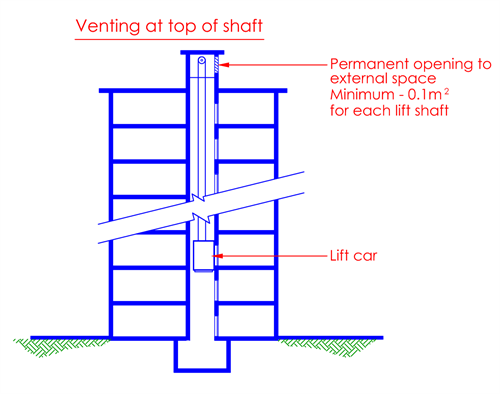
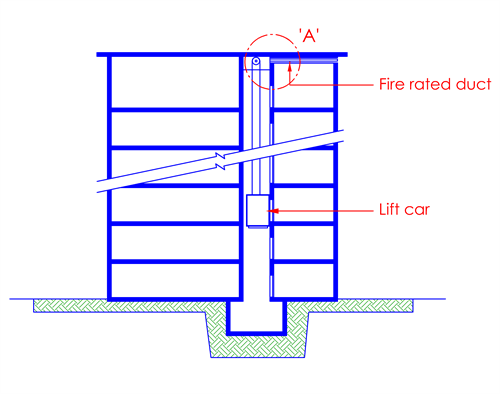
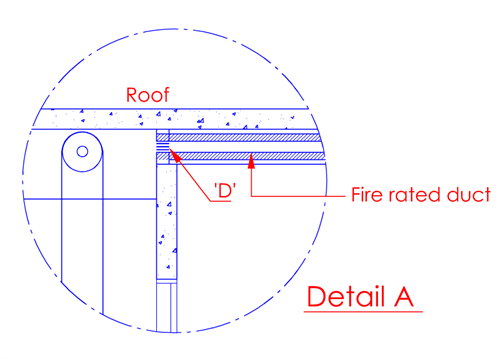
-1.tmb-firecode.png?Culture=en&sfvrsn=2f789c34_1)
-2.tmb-firecode.png?Culture=en&sfvrsn=32bdceba_1)
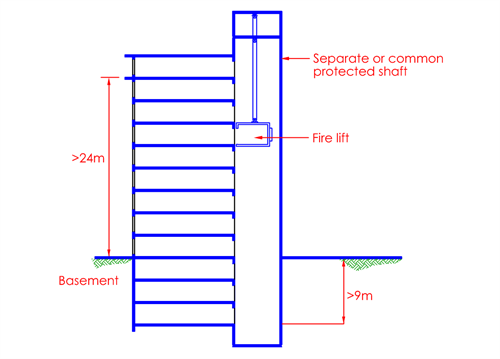
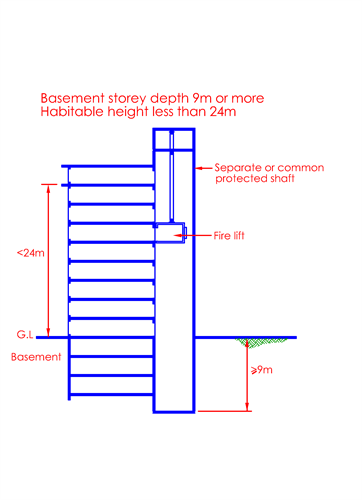

.tmb-firecode.png?Culture=en&sfvrsn=2c057dc2_1)
-1.tmb-firecode.png?Culture=en&sfvrsn=f0bf168b_1)
-2.tmb-firecode.png?Culture=en&sfvrsn=6202aa6c_1)
-3.tmb-firecode.png?Culture=en&sfvrsn=86378ea4_1)
